Design Method of Controllable Blade Angle and Orthogonal Optimization of Pressure Rise for a Multiphase Pump
Abstract
:1. Introduction
2. Design Method Based on Controllable Blade Angle
- (1)
- The blade angle at the leading edge:, corresponding to ;
- (2)
- The blade angle at the trailing edge:, corresponding to ;
- (3)
- The non-incidence condition at the leading edge:, corresponding to ;
- (4)
- The Kutta-Joukowsky condition at the trailing edge:, corresponding to ;
- (5)
- The value of f(x) at middle point of relative meridional streamline x = 0.5 is given as k.
- (1)
- Identical wrap angle at impeller outlet should be met to suppress the gas-liquid separation due to centrifugal force, which satisfies the following equation:
- (2)
- Supposing uniform velocity moment between impeller outlet and diffuser inlet because of none extra velocity moment in the vaneless region, βDh0 and βDs0 can be determined, as shown in Figure 2:where c, w, u are absolute velocity, relative velocity and circumferential velocity, respectively. cu and cm are the circumferential and meridional component of absolute velocity.
- (3)
- Axial outflow for diffuser is required, so the values of βDh1 and βDs1 are set as 90°.
3. Physical Model and Computational Domain
4. Numerical Methods and Settings
4.1. Numerical Method
4.2. Independence Test of Mesh Number
4.3. Simulation Accuracy Validation
5. Orthogonal Optimization Design
5.1. Optimization Design Parameters
5.2. Orthogonal Table
6. Result and Discussion
6.1. Orthogonal Analysis
6.2. Orthogonal Optimization
6.3. Optimization Results
7. Conclusions
- (1)
- According to the orthogonal analysis, the influence of five geometry parameters on pressure rise can be sorted by: βIs0 > ks > kh > ∆βI0 > βIs1.
- (2)
- The performance of multiphase pump with optimization geometry parameters is enhanced when compared with the base pump. The pressure rise is increased by 12.8 kPa under design flow rate with 10% inlet gas volume fraction.
- (3)
- The distribution of gas volume fraction and the pressure inside multiphase pump of base mode and optimization pump is compared. It can be found that the distribution becomes more uniform after optimization, which improves the transporting performance of the optimization pump.
Acknowledgments
Author Contributions
Conflicts of Interest
References
- Dal Porto, D.F.; Larson, L.A. Multiphase-pump field trails demonstrate practical applications for the technology. SPE Prod. Facil. 1997, 12, 159–164. [Google Scholar] [CrossRef]
- Rabiger, K.; Maksoud, T.M.A.; Ward, J.; Hausmann, G. Theoretical and experimental analysis of a multiphase screw pump, handling gas-liquid mixtures with very high gas volume fractions. Exp. Therm. Fluid Sci. 2008, 32, 1694–1701. [Google Scholar] [CrossRef]
- Cao, S.L.; Peng, G.Y.; Yu, Z.Y. Hydrodynamics design of rotodynamics pump impeller for multiphase pumping by combined approach of inverse design and CFD analysis. J. Fluids Eng. 2005, 127, 330–338. [Google Scholar] [CrossRef]
- Zhang, J.Y.; Cai, S.J.; Zhu, H.W.; Zhang, Y.X. Experimental investigation of the flow at the entrance of a rotodynamic multiphase pump by visualization. J. Pet. Sci. Eng. 2015, 126, 254–261. [Google Scholar] [CrossRef]
- Zhang, J.Y.; Cai, S.J.; Li, Y.J.; Zhu, H.W.; Zhang, Y.X. Visualization study of gas-liquid two-phase flow patterns inside a three-stage rotodynamic multiphase pump. Exp. Therm. Fluid Sci. 2016, 70, 125–138. [Google Scholar] [CrossRef]
- Zhang, J.Y.; Li, Y.J.; Cai, S.J.; Zhu, H.W.; Zhang, Y.X. Investigation on the gas pockets in a rotodynamic multiphase pump. IOP Conf. Ser. Mater. Sci. Eng. 2016, 129, 012007. [Google Scholar] [CrossRef]
- Tan, L.; Zhu, B.S.; Cao, S.L.; Wang, Y.C.; Wang, B.B. Numerical simulation of unsteady cavitation flow in a centrifugal pump at off-design conditions. Proc. Inst. Mech. Eng. Part C J. Mech. Eng. Sci. 2014, 228, 1994–2006. [Google Scholar]
- Tan, L.; Zhu, B.S.; Wang, Y.C.; Cao, S.L.; Gui, S.B. Numerical study on characteristics of unsteady flow in a centrifugal pump volute at partial load condition. Eng. Comput. 2015, 32, 1549–1566. [Google Scholar] [CrossRef]
- Tan, L.; Yu, Z.Y.; Xu, Y.; Liu, Y.B.; Cao, S.L. Role of blade rotational angle on energy performance and pressure fluctuation of a mixed-flow pump. Proc. Inst. Mech. Eng. Part A J. Power Energy 2017, 231, 227–238. [Google Scholar]
- Yu, Z.Y.; Zhu, B.S.; Cao, S.L.; Wang, G.Y. Application of two-fluid model in the unsteady flow simulation for a multiphase rotodynamic pump. IOP Conf. Ser. Mater. Sci. Eng. 2013, 52, 062003. [Google Scholar] [CrossRef]
- Yu, Z.Y.; Zhu, B.S.; Cao, S.L.; Liu, Y. Effect of virtual mass force on the mixed transport process in a multiphase rotodynamic pump. Adv. Mech. Eng. 2014, 2, 958352. [Google Scholar] [CrossRef]
- Yu, Z.Y.; Zhu, B.S.; Cao, S.L. Interphase force analysis for air-water bubbly flow in a multiphase rotodynamic pump. Eng. Comput. 2015, 32, 2166–2180. [Google Scholar] [CrossRef]
- Zhang, J.Y.; Zhu, H.W.; Yang, C.; Li, Y.; Wei, H. Multi-objective shape optimization of helico-axial multiphase pump impeller based NSGA-II and ANN. Energy Convers. Manag. 2011, 52, 538–546. [Google Scholar] [CrossRef]
- Hu, H.; Li, X.K.; Gu, B. Hydraulic optimization of multiphase pump based on CFD and genetic algorithm. International J. Grid Distrib. Comput. 2015, 8, 161–170. [Google Scholar]
- Zhang, J.Y.; Cai, S.J.; Li, Y.J.; Zhou, X.; Zhang, Y.X. Optimization design of multiphase pump impeller based on combined genetic algorithm and boundary vortex flux diagnosis. J. Hydrodyn. 2017, 29, 1023–1034. [Google Scholar] [CrossRef]
- Kim, J.H.; Lee, H.C.; Kim, J.H.; Choi, Y.S.; Yoon, J.Y.; Yoo, I.S.; Choi, W.C. Improvement of hydrodynamic performance if a multiphase pump using design of experiment techniques. J. Fluid Eng. 2015, 137, 081301. [Google Scholar] [CrossRef]
- Suh, J.W.; Kim, J.H.; Choi, Y.S.; Joo, W.G.; Lee, K.Y. A study on numerical optimization and performance verification of multiphase pump for offshore plant. Proc. Inst. Mech. Eng. Part A J. Power Energy 2017, 231, 382–397. [Google Scholar] [CrossRef]
- Suh, J.W.; Kim, J.W.; Choi, Y.S.; Kim, J.H.; Joo, W.G.; Lee, K.Y. Multi-objective optimization of the hydrodynamic performance of the second stage of a multi-phase pump. Energies 2017, 10, 1334. [Google Scholar] [CrossRef]
- Byrne, D.M.; Taguchi, S. The Taguchi approach to parameter design. Qual. Prog. 1987, 20, 19–26. [Google Scholar]
- Shi, W.D.; Wang, C.; Lu, W.G.; Zhou, L.; Zhang, L. Optimization design of stainless steel stamping multistage pump based on orthogonal test. Int. J. Fluid Mach. Syst. 2010, 3, 309–314. [Google Scholar]
- Zhou, L.; Shi, W.D.; Lu, W.G. Orthogonal test design and numerical simulation of 100QJ10 Type deep-well pump. Appl. Mech. Mater. 2012, 110, 2590–2595. [Google Scholar] [CrossRef]
- Zhou, L.; Shi, W.D.; Wu, S.Q. Performance optimization in a centrifugal pump impeller by orthogonal experiment and numerical simulation. Adv. Mech. Eng. 2013, 5, 385809. [Google Scholar] [CrossRef]
- Zhao, B.J.; Hou, D.H.; Chen, H.L.; Wang, Y.; Qiu, J. Optimization design of a double-channel pump by means of orthogonal test, CFD, and experimental analysis. Adv. Mech. Eng. 2014, 6, 545216. [Google Scholar] [CrossRef]
- Xu, Y.; Tan, L.; Cao, S.L.; Qu, W.S. Multiparameter and multiobjective optimization design of centrifugal pump based on orthogonal method. Proc. Inst. Mech. Eng. Part C J. Mech. Eng. Sci. 2017, 231, 2569–2579. [Google Scholar] [CrossRef]
- Zhang, Y.X.; Zhang, J.Y.; Zhu, H.W.; Cai, S.J. 3D blade hydraulic design method of the rotodynmic multiphase pump impeller and performance research. Adv. Mech. Eng. 2014, 6, 803972. [Google Scholar] [CrossRef]
- Tan, L.; Cao, S.L.; Gui, S.B. Hydraulic design and pre-whirl regulation law of inlet guide vane for centrifugal pump. Sci. China Technol. Sci. 2010, 53, 2142–2151. [Google Scholar] [CrossRef]
- Menter, F.R. Two-Equation Eddy-Viscosity Turbulence Models for Engineering Applications. AIAA J. 1994, 32, 1598–1605. [Google Scholar] [CrossRef]
- ANSYS Inc. ANSYS14.5 Help, CFX, Theory Guide; ANSYS Inc.: Canonsburg, PA, USA, 2014. [Google Scholar]
- Clift, R.; Grace, J.R.; Weber, M.E. Bubbles, Drops and Particles; Academic Press: New York, NY, USA, 1978. [Google Scholar]
- Sato, Y.; Sekoguchi, K. Liquid velocity distribution in two-phase bubble flow. Int. J. Multiph. Flow 1973, 2, 79–85. [Google Scholar] [CrossRef]
- Hao, Y.; Tan, L.; Liu, Y.B.; Xu, Y.; Zhang, J.S.; Zhu, B.S. Energy performance and radial force of a mixed-flow pump with symmetrical and unsymmetrical tip clearances. Energies 2017, 10, 57. [Google Scholar] [CrossRef]
- Liu, Y.B.; Tan, L.; Hao, Y.; Xu, Y. Energy performance and flow patterns of a mixed-flow pump with different tip clearance sizes. Energies 2017, 10, 191. [Google Scholar] [CrossRef]
- Tan, L.; Xie, Z.F.; Liu, Y.B.; Hao, Y.; Xu, Y. Influence of T-shape tip clearance on performance of a mixed-flow pump. Proc. Inst. Mech. Eng. Part A J. Power Energy 2017. [Google Scholar] [CrossRef]
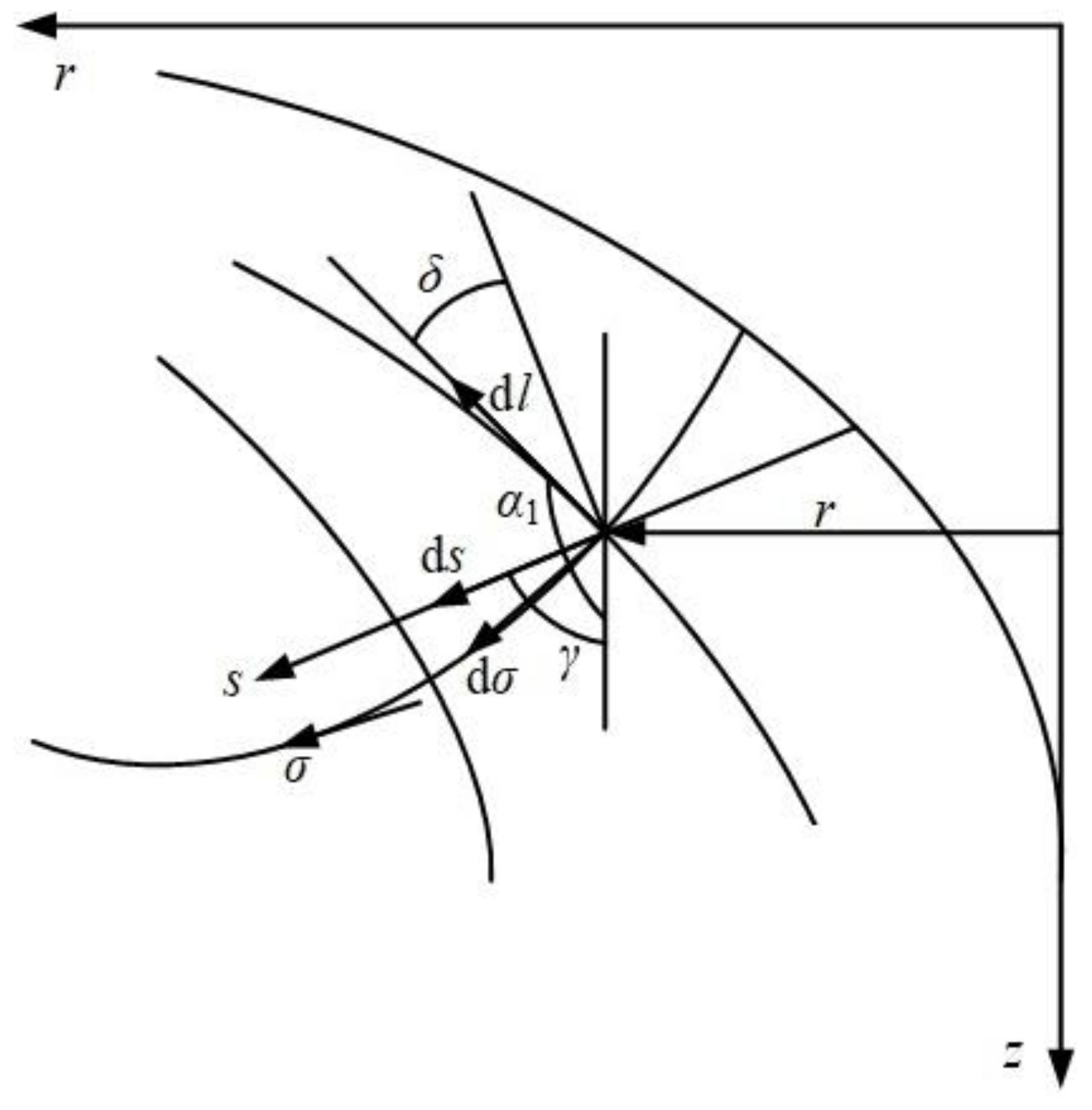
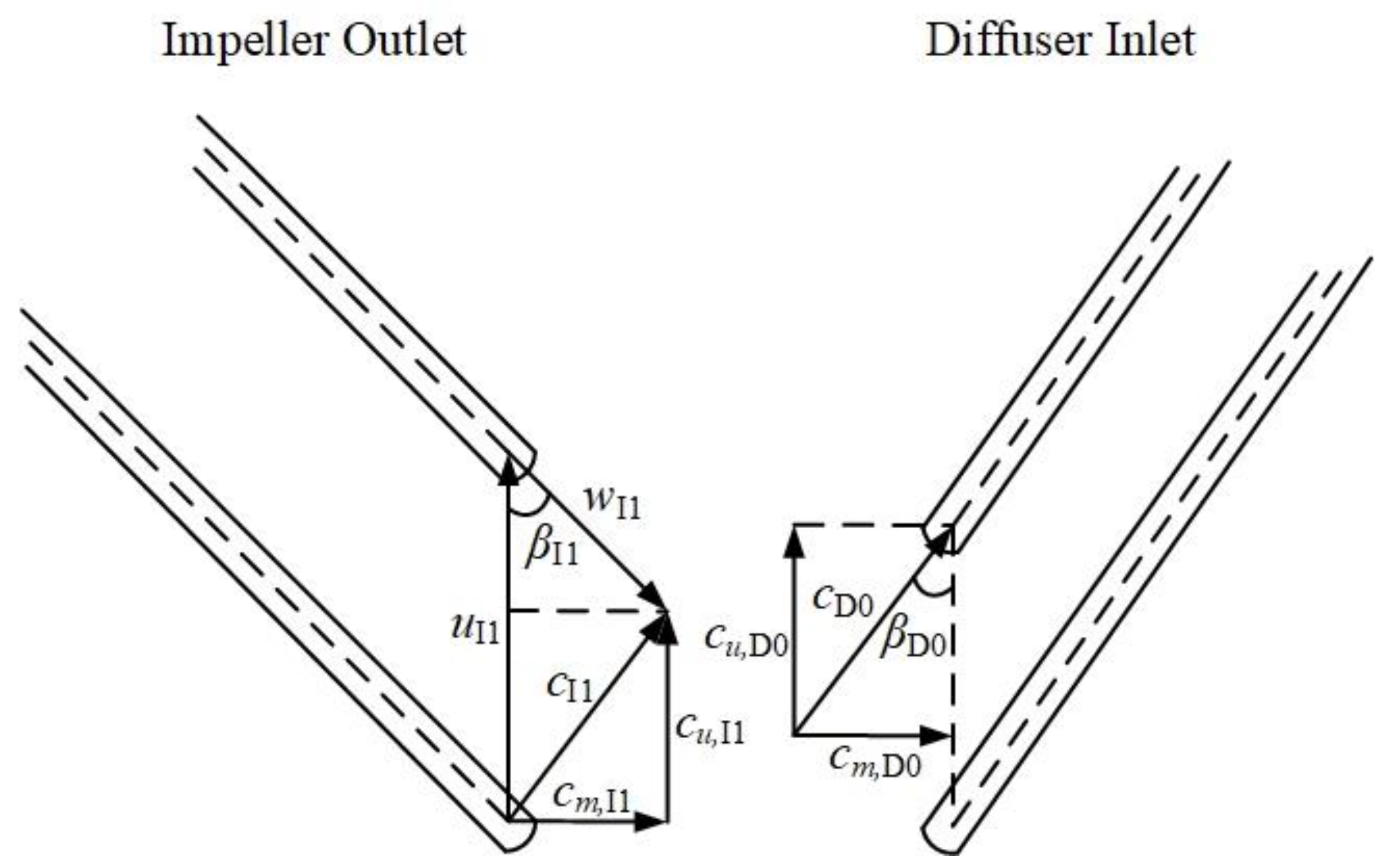

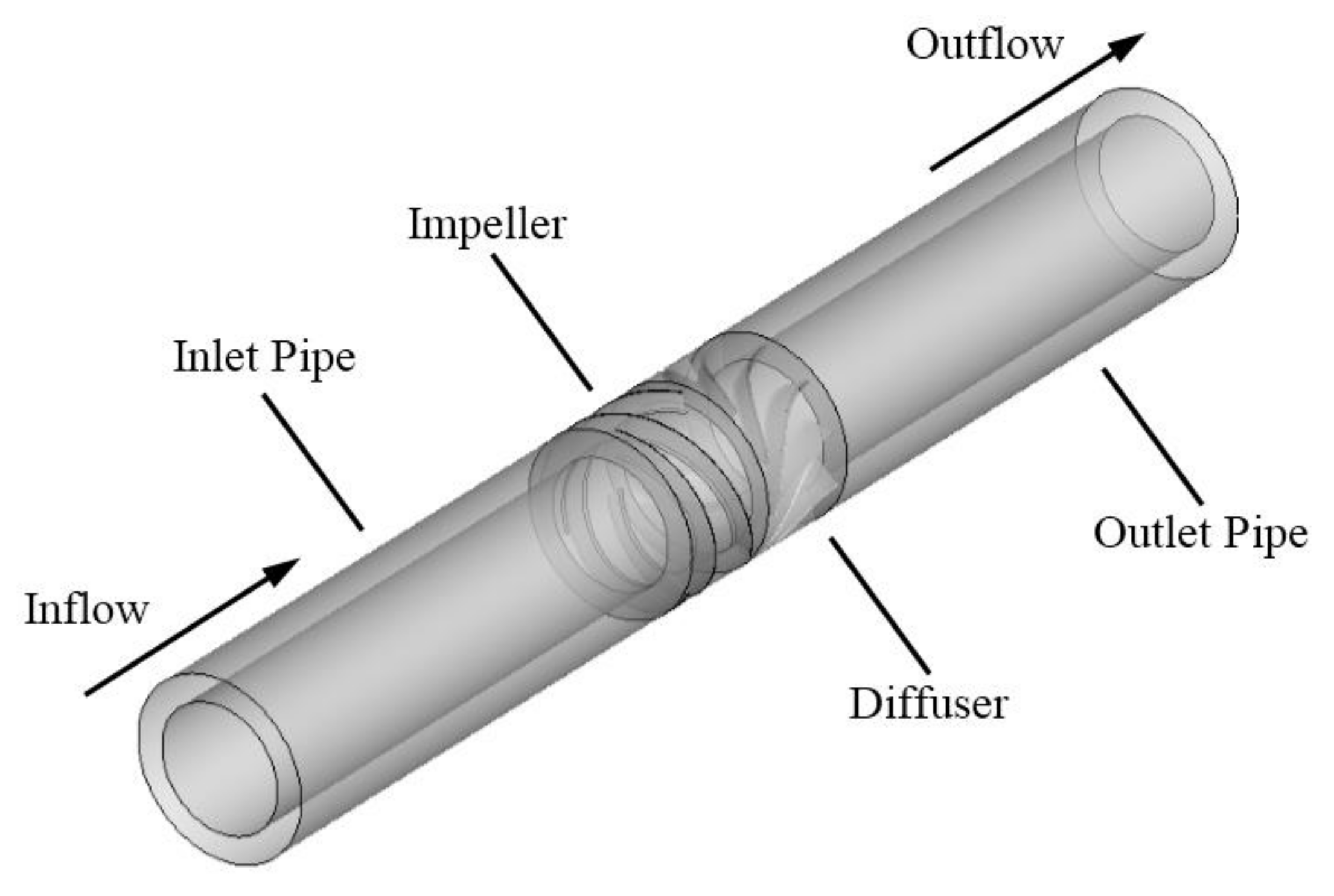
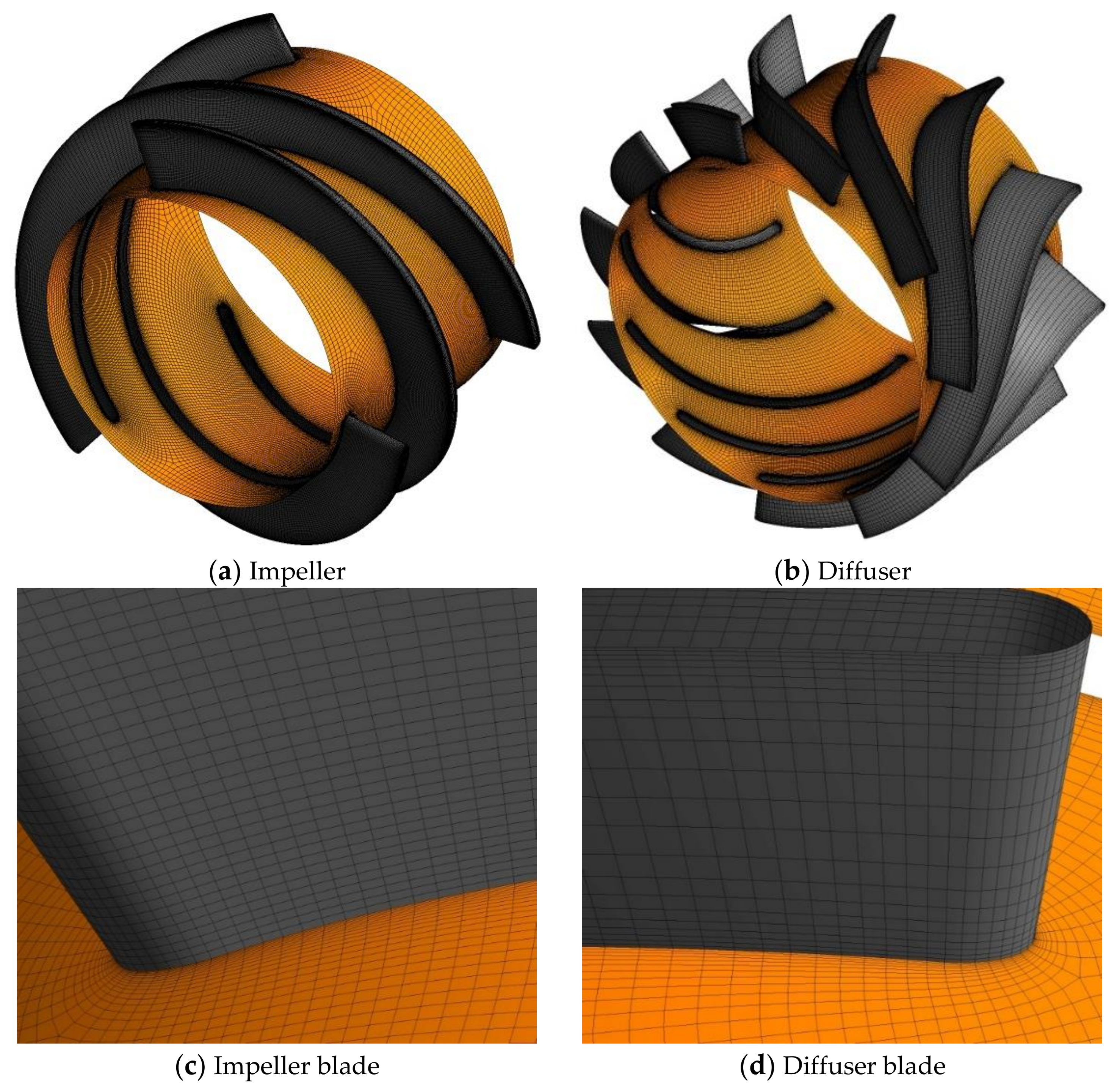
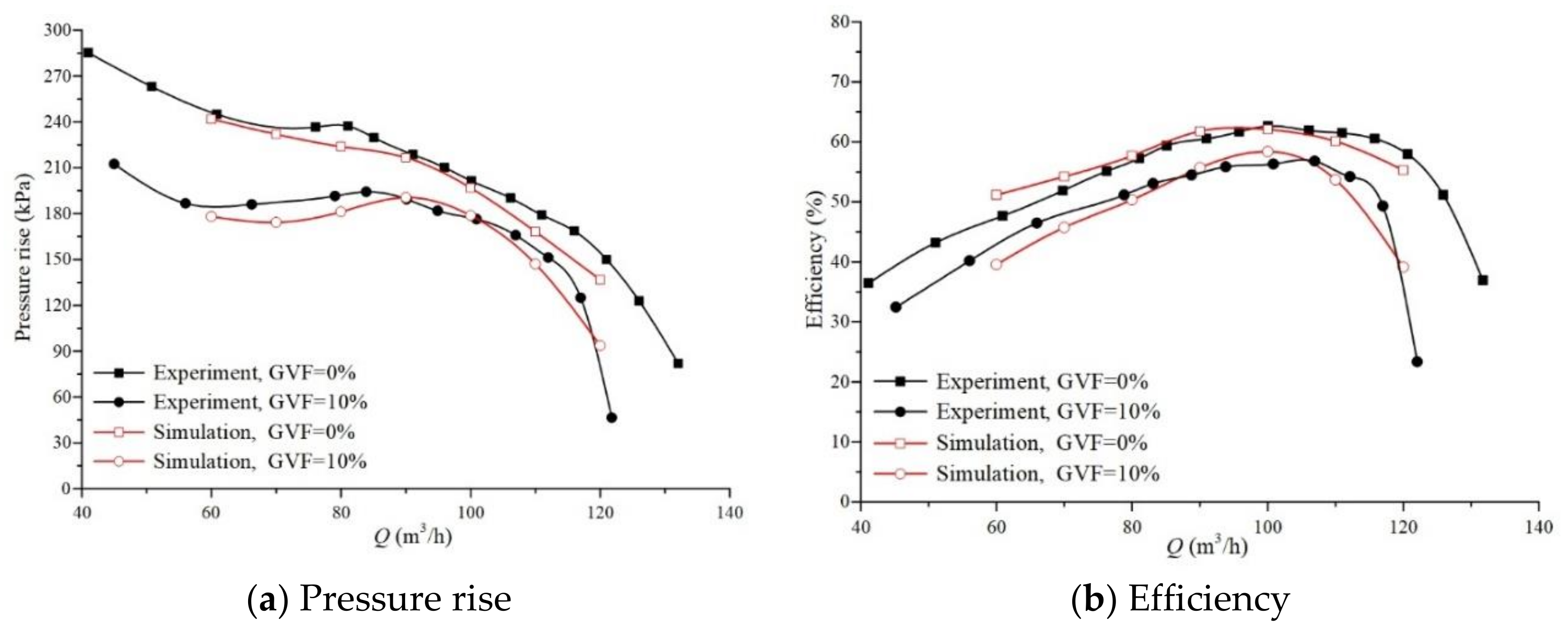
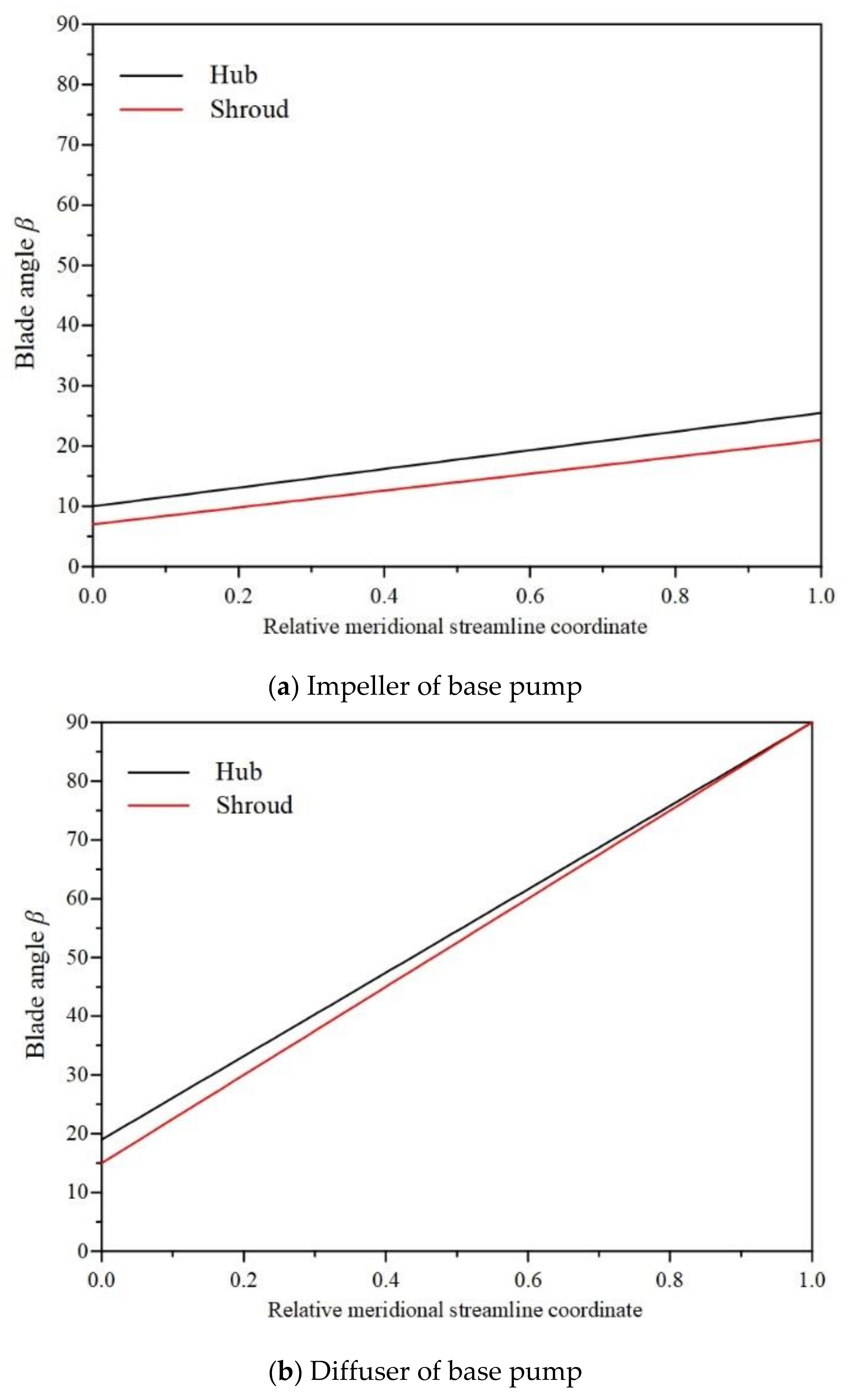
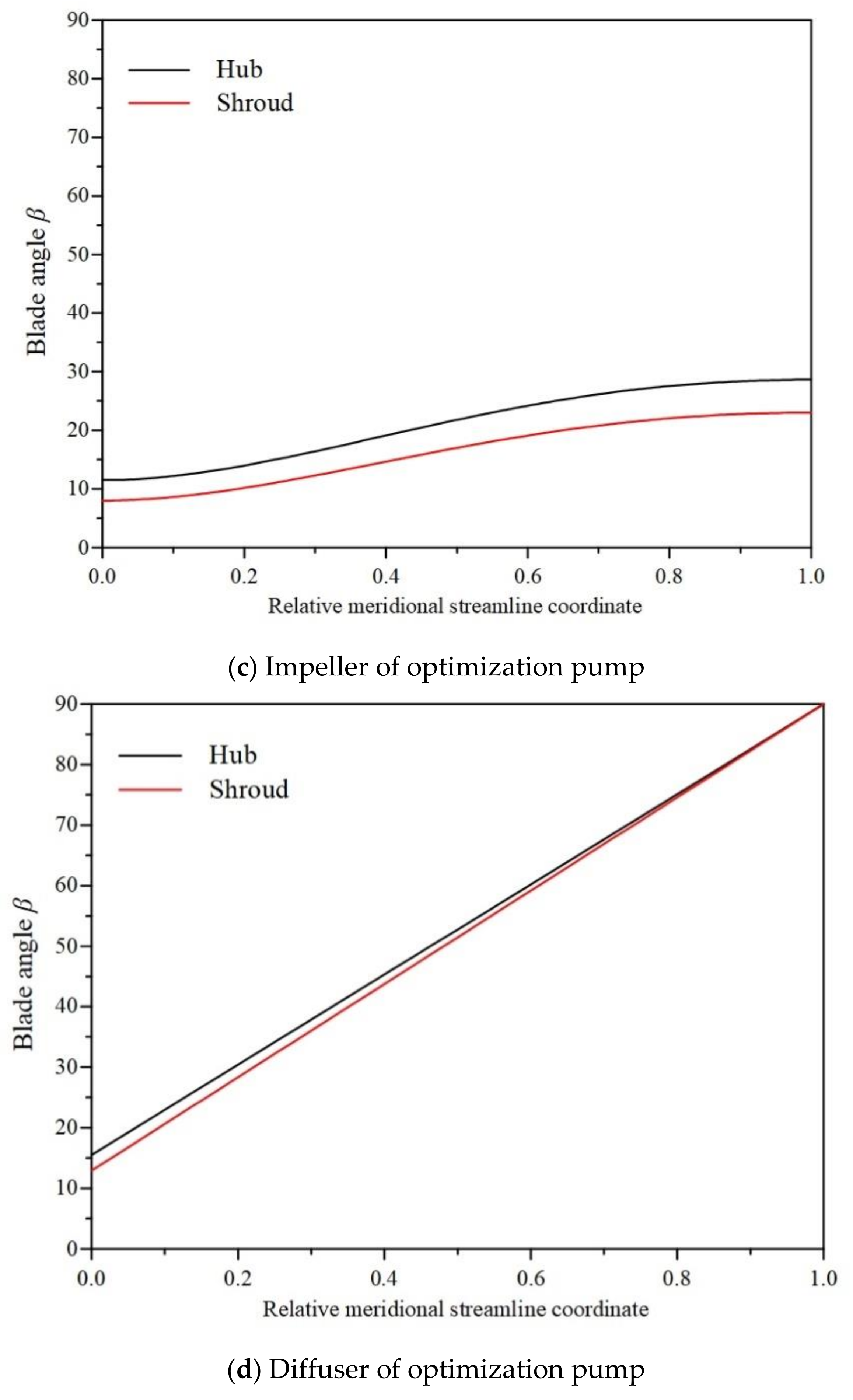


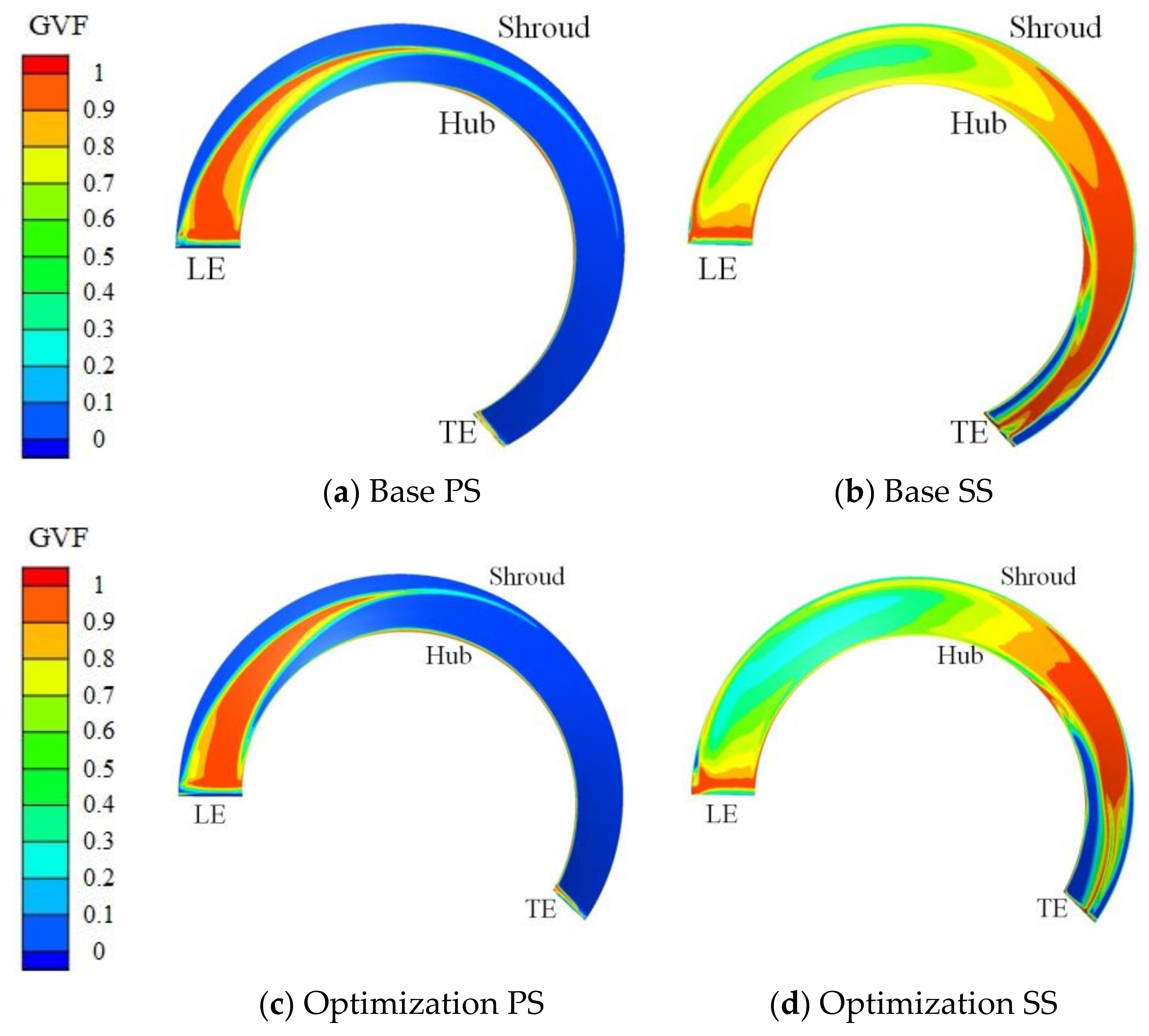
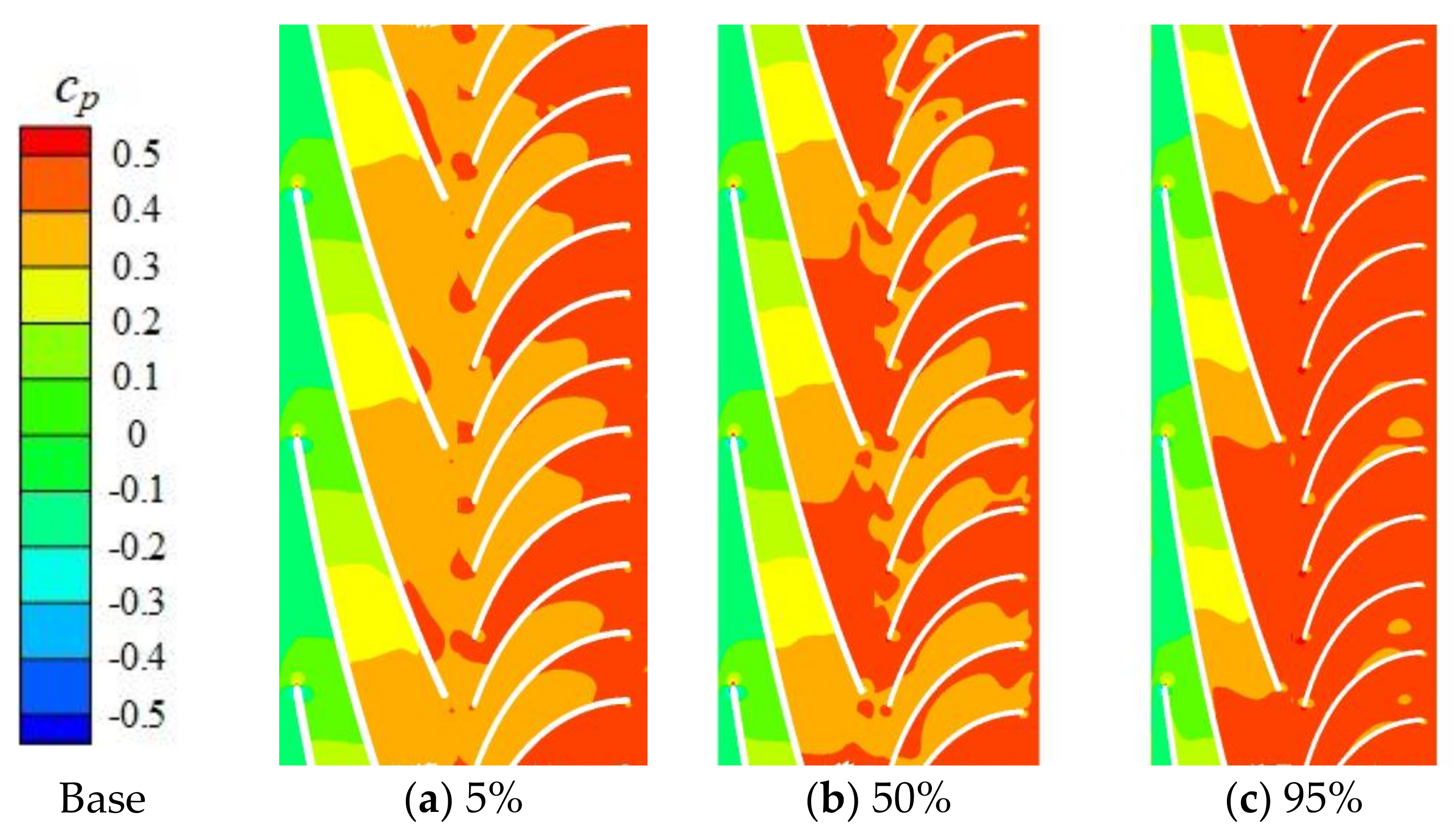
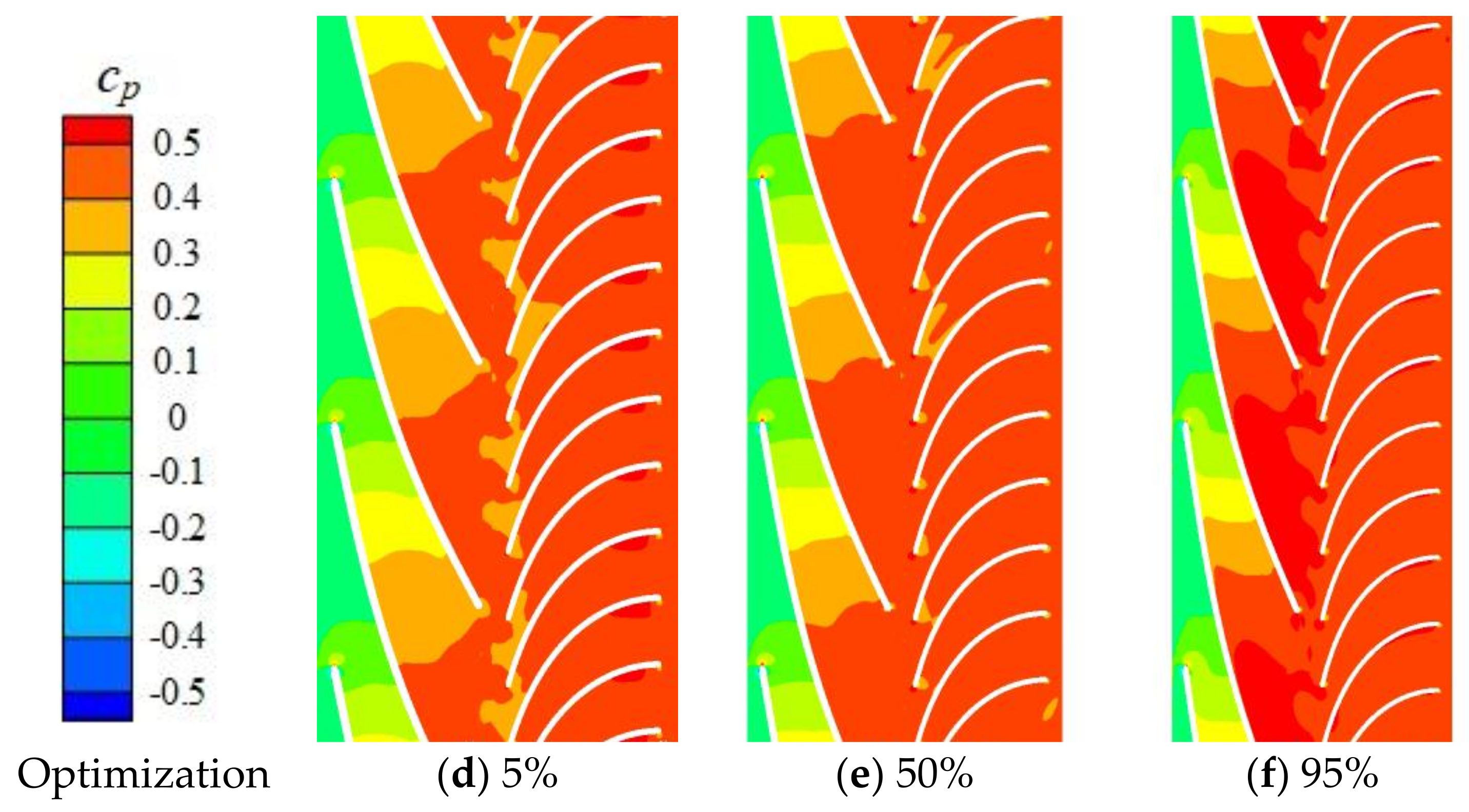

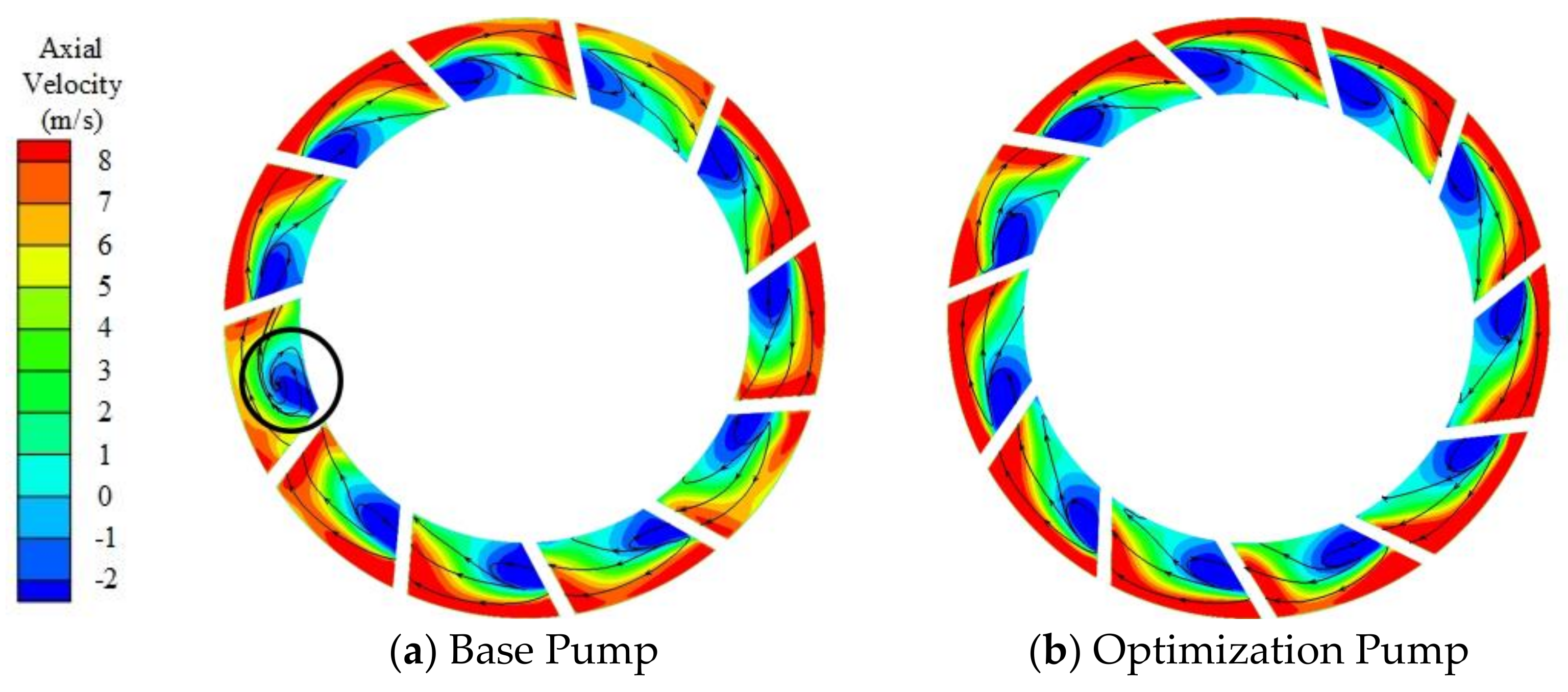
| Item | Value |
|---|---|
| Rotational speed | 3600 rpm |
| Pressure rise (GVF = 0%) | 230 kPa |
| Rated flow rate | 100 m3/h |
| Item | Mesh 1 | Mesh 2 | Mesh 3 | Mesh 4 | |
|---|---|---|---|---|---|
| Inlet pipe | 443,916 | 443,916 | 443,916 | 443,916 | |
| Impeller | 1,711,005 | 2,324,412 | 2,829,252 | 3,442,440 | |
| Diffuser | 790,020 | 1,079,804 | 1,337,688 | 1,613,898 | |
| Outlet pipe | 907,236 | 907,236 | 907,236 | 907,236 | |
| Total | 3,852,177 | 4,755,368 | 5,518,092 | 6,407,490 | |
| GVF = 0 | Pressure rise (kPa) | 198.8 | 196.8 | 197.0 | 196.2 |
| Efficiency (%) | 62.63 | 62.05 | 62.01 | 61.72 | |
| GVF = 10% | Pressure rise (kPa) | 178.8 | 178.8 | 178.2 | 178.8 |
| Efficiency (%) | 58.32 | 58.37 | 58.15 | 58.32 | |
| Level | Factor | ||||
|---|---|---|---|---|---|
| βIs0 | ∆βI0 | βIs1 | kh | ks | |
| 1 | 6.5 | 2 | 20 | 0.45 | 0.45 |
| 2 | 7 | 2.5 | 21 | 0.5 | 0.5 |
| 3 | 7.5 | 3 | 22 | 0.55 | 0.55 |
| 4 | 8 | 3.5 | 23 | 0.6 | 0.6 |
| Individual No. | Factor | ||||
|---|---|---|---|---|---|
| βIs0 | ∆βI0 | βIs1 | kh | ks | |
| 1 | 6.5 | 2 | 20 | 0.45 | 0.45 |
| 2 | 6.5 | 2.5 | 21 | 0.55 | 0.6 |
| 3 | 6.5 | 3 | 22 | 0.6 | 0.5 |
| 4 | 6.5 | 3.5 | 23 | 0.5 | 0.55 |
| 5 | 7 | 2 | 21 | 0.5 | 0.5 |
| 6 | 7 | 2.5 | 20 | 0.6 | 0.55 |
| 7 | 7 | 3 | 23 | 0.55 | 0.45 |
| 8 | 7 | 3.5 | 22 | 0.45 | 0.6 |
| 9 | 7.5 | 2 | 22 | 0.55 | 0.55 |
| 10 | 7.5 | 2.5 | 23 | 0.45 | 0.5 |
| 11 | 7.5 | 3 | 20 | 0.5 | 0.6 |
| 12 | 7.5 | 3.5 | 21 | 0.6 | 0.45 |
| 13 | 8 | 2 | 23 | 0.6 | 0.6 |
| 14 | 8 | 2.5 | 22 | 0.5 | 0.45 |
| 15 | 8 | 3 | 21 | 0.45 | 0.55 |
| 16 | 8 | 3.5 | 20 | 0.55 | 0.5 |
| Individual No. | Pressure Rise ∆p (kPa) |
|---|---|
| 1 | 130.73 |
| 2 | 163.41 |
| 3 | 155.58 |
| 4 | 162.96 |
| 5 | 153.71 |
| 6 | 164.41 |
| 7 | 162.73 |
| 8 | 171.41 |
| 9 | 174.80 |
| 10 | 159.59 |
| 11 | 178.22 |
| 12 | 169.28 |
| 13 | 188.09 |
| 14 | 172.00 |
| 15 | 179.53 |
| 16 | 176.35 |
| βIs0 | ∆βI0 | βIs1 | kh | ks | |
|---|---|---|---|---|---|
| 153.17 | 161.83 | 162.43 | 160.31 | 158.68 | |
| 163.06 | 164.85 | 166.48 | 169.32 | 175.28 | |
| 170.47 | 169.01 | 168.44 | 169.34 | 161.31 | |
| 178.99 | 170.00 | 168.34 | 166.72 | 170.42 | |
| R | 25.82 | 8.17 | 6.02 | 9.03 | 16.59 |
© 2018 by the authors. Licensee MDPI, Basel, Switzerland. This article is an open access article distributed under the terms and conditions of the Creative Commons Attribution (CC BY) license (http://creativecommons.org/licenses/by/4.0/).
Share and Cite
Liu, M.; Tan, L.; Cao, S. Design Method of Controllable Blade Angle and Orthogonal Optimization of Pressure Rise for a Multiphase Pump. Energies 2018, 11, 1048. https://doi.org/10.3390/en11051048
Liu M, Tan L, Cao S. Design Method of Controllable Blade Angle and Orthogonal Optimization of Pressure Rise for a Multiphase Pump. Energies. 2018; 11(5):1048. https://doi.org/10.3390/en11051048
Chicago/Turabian StyleLiu, Ming, Lei Tan, and Shuliang Cao. 2018. "Design Method of Controllable Blade Angle and Orthogonal Optimization of Pressure Rise for a Multiphase Pump" Energies 11, no. 5: 1048. https://doi.org/10.3390/en11051048
APA StyleLiu, M., Tan, L., & Cao, S. (2018). Design Method of Controllable Blade Angle and Orthogonal Optimization of Pressure Rise for a Multiphase Pump. Energies, 11(5), 1048. https://doi.org/10.3390/en11051048






